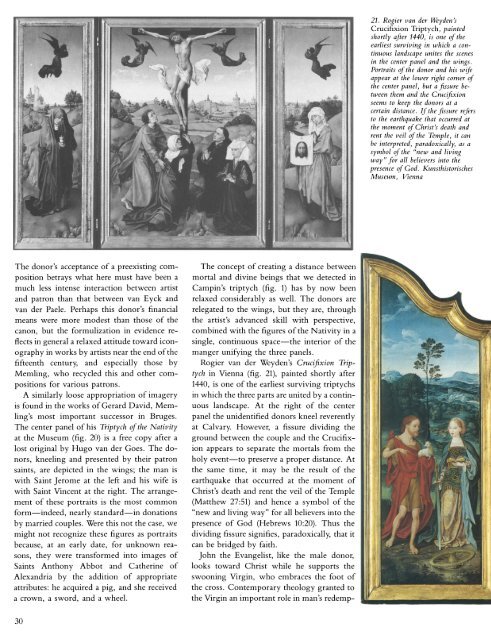Early Flemish Portraits 1425-1525: The Metropolitan Museum of Art ...
Early Flemish Portraits 1425-1525: The Metropolitan Museum of Art ...
Early Flemish Portraits 1425-1525: The Metropolitan Museum of Art ...
You also want an ePaper? Increase the reach of your titles
YUMPU automatically turns print PDFs into web optimized ePapers that Google loves.
21. Rogier van der Weyden's<br />
Crucifixion Triptych, painted<br />
shortly after 1440, is one <strong>of</strong> the<br />
earliest surviving in which a continuous<br />
landscape unites the scenes<br />
in the center panel and the wings.<br />
<strong>Portraits</strong> <strong>of</strong> the donor and his wife<br />
appear at the lower right corner <strong>of</strong><br />
the center panel, but a fissure between<br />
them and the Crucifixion<br />
seems to keep the donors at a<br />
certain distance. If the fissure refers<br />
to the earthquake that occurred at<br />
the moment <strong>of</strong> Christ's death and<br />
rent the veil <strong>of</strong> the Temple, it can<br />
be interpreted, paradoxically, as a<br />
symbol <strong>of</strong> the "new and living<br />
way" for all believers into the<br />
presence <strong>of</strong> God. Kunsthistorisches<br />
<strong>Museum</strong>, Vienna<br />
<strong>The</strong> donor's acceptance <strong>of</strong> a preexisting com-<br />
position betrays what here must have been a<br />
much less intense interaction between artist<br />
and patron than that between van Eyck and<br />
van der Paele. Perhaps this donor's financial<br />
means were more modest than those <strong>of</strong> the<br />
canon, but the formulization in evidence reflects<br />
in general a relaxed attitude toward iconography<br />
in works by artists near the end <strong>of</strong> the<br />
fifteenth century, and especially those by<br />
Memling, who recycled this and other compositions<br />
for various patrons.<br />
A similarly loose appropriation <strong>of</strong> imagery<br />
is found in the works <strong>of</strong> Gerard David, Mem-<br />
ling's most important successor in Bruges.<br />
<strong>The</strong> center panel <strong>of</strong> his Triptych <strong>of</strong> the Nativity<br />
at the <strong>Museum</strong> (fig. 20) is a free copy after a<br />
lost original by Hugo van der Goes. <strong>The</strong> donors,<br />
kneeling and presented by their patron<br />
saints, are depicted in the wings; the man is<br />
with Saint Jerome at the left and his wife is<br />
with Saint Vincent at the right. <strong>The</strong> arrangement<br />
<strong>of</strong> these portraits is the most common<br />
form-indeed, nearly standard-in donations<br />
by married couples. Were this not the case, we<br />
might not recognize these figures as portraits<br />
because, at an early date, for unknown reasons,<br />
they were transformed into images <strong>of</strong><br />
Saints Anthony Abbot and Catherine <strong>of</strong><br />
Alexandria by the addition <strong>of</strong> appropriate<br />
attributes: he acquired a pig, and she received<br />
a crown, a sword, and a wheel.<br />
<strong>The</strong> concept <strong>of</strong> creating a distance between<br />
mortal and divine beings that we detected in<br />
Campin's triptych (fig. 1) has by now been<br />
relaxed considerably as well. <strong>The</strong> donors are<br />
relegated to the wings, but they are, through<br />
the artist's advanced skill with perspective,<br />
combined with the figures <strong>of</strong> the Nativity in a<br />
single, continuous space-the interior <strong>of</strong> the<br />
manger unifying the three panels.<br />
Rogier van der Weyden's Crucifixion Triptych<br />
in Vienna (fig. 21), painted shortly after<br />
1440, is one <strong>of</strong> the earliest surviving triptychs<br />
in which the three parts are united by a continuous<br />
landscape. At the right <strong>of</strong> the center<br />
panel the unidentified donors kneel reverently<br />
at Calvary. However, a fissure dividing the<br />
ground between the couple and the Crucifixion<br />
appears to separate the mortals from the<br />
holy event-to preserve a proper distance. At<br />
the same time, it may be the result <strong>of</strong> the<br />
earthquake that occurred at the moment <strong>of</strong><br />
Christ's death and rent the veil <strong>of</strong> the Temple<br />
(Matthew 27:51) and hence a symbol <strong>of</strong> the<br />
"new and living way" for all believers into the<br />
presence <strong>of</strong> God (Hebrews 10:20). Thus the<br />
dividing fissure signifies, paradoxically, that it<br />
can be bridged by faith.<br />
John the Evangelist, like the male donor,<br />
looks toward Christ while he supports the<br />
swooning Virgin, who embraces the foot <strong>of</strong><br />
the cross. Contemporary theology granted to<br />
the Virgin an important role in man's redemp-

















